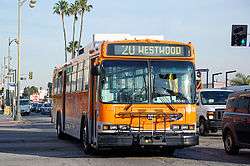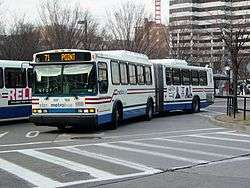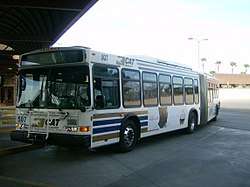Neoplan USA
Neoplan USA was a major transit bus manufacturing company based in Denver, Colorado, which was entirely separate from the German corporation, Neoplan, licensing its designs from the German company of the same name. The company was founded in 1981 and folded in 2006. It was originally a subsidiary of Neoplan, but later became an independent licensee. Its main factory was located in Lamar, Colorado.[1]
| Industry | Transit |
|---|---|
| Fate | Bankruptcy/liquidation |
| Founded | 1981 (Lamar, Colorado), as a subsidiary of Neoplan |
| Defunct | 2006 |
| Headquarters | Denver, Colorado |
| Products | Buses |
Number of employees | 625 |



Its headquarters was also in Lamar, until moving to Denver in 2004.[2] At one time, it also had production facilities in Honey Brook, Pennsylvania, and Brownsville, Texas.
Neoplan opened its first American manufacturing facility in Lamar, Colorado in 1981. It was a 139,000-square-foot (12,900 m2) plant on an 18-acre (7.3 ha) site. The city of Lamar, a farming town of 8,000 that faced tough economic times, pushed to have the plant built in the town in the hope of diversifying their economic base. It donated land and roads for the manufacturing site. The street that went to the plant was renamed Gottlob Auwaerter Drive, after the name of the founder of Neoplan, the name of which it did business as. Company officials were reported to look for a rural site "because of their conviction, based on experience in Europe, that rural workers have a better work ethic and are more reliable and productive employees".[3]
Neoplan manufactured standard-floor buses, low-floor buses, and articulated buses.
Later in 1981, its first year of operation, Neoplan sold 46 articulated buses to Metropolitan Atlanta Rapid Transit Authority. This was also a year when “articulated” buses, extra-long buses that bent in the middle, were gaining interest with transit departments. As the federal government was phasing out subsidies for mass transit, these buses got attention because they were cost effective. They carried more passengers and saved on labor costs, as they required only one driver.[4]
Neoplan's share of the United States bus market was 1.3 percent in 1981, grew to 10.4 percent in 1982, and went to 25.2 percent in 1983 based on production orders.[5]
In 2003–2006 it also built 28 40-foot (12 m) electric trolley buses and 32 articulated dual-mode buses for Boston's MBTA.[1] Neoplan had 625 employees and revenue of $810 million before it ceased operations in January 2006.
Neoplan USA filed for Chapter 11 bankruptcy protection in August 2006,[6] listing assets of $13.7 million and debts of $59 million, after closing its manufacturing plant in 2006.
In its last few months of operation, Neoplan had fallen on hard times, such as warranty issues with San Francisco's MUNI and cash-flow problems after Boston's MBTA canceled an order due to late deliveries.[7]
The company still technically continued to exist until selling its parts-supply division, Neopart. Once Neopart was sold, in October 2007,[8][9] Neoplan USA ceased to exist.
Manufacturing Defects
When Neoplan opened in Lamar in 1981, company officials said the plant would employ up to 500 people, and manufacture as many as 500 vehicles a year on two assembly lines. Their contracts included 50 transit buses for Metropolitan Atlanta Transit Authority and 40 for Milwaukee. Contracts for another 500 were being bid on.
Throughout its history Neoplan buses had a series of manufacturing defects.
Washington D.C.
In June 1983 76 buses from Neoplan were purchased by the Metro Transit Authority of Washington D.C. for $12.5 million. In 1984 Metro found hairline cracks in 32 Neoplan buses.[10] The cracks were in the undercarriage of the buses, “...in a weld joining a steel frame above the rear axle with a component that helps support the bus suspension system.”[11]
On December 23, 1984 a Neoplan bus in operation was destroyed in a fire, caused by a faulty electrical circuit. A National Highway and Traffic Safety Administration (NHTSA) investigation found the fire was due to excessive amperage in a protective circuit breaker and an absence of a cutoff switch.[12]
In February 1985 cracks were found in all of the remaining 75 Neoplan buses in service in D.C. These cracks were near the front axles and could have led to loss of steering control. Other cracks were found in steel plates, tubes and welds. This led to Metro halting the service of all Neoplan buses, which mainly served the southeastern Washington D.C. area.[13]
Neoplan USA president Robert Lee pledged to repair the buses at the company's expense, saying it was a minor repair that did not create safety problems. Fairfax County Supervisor Joseph Alexander, a member of the Metro Board, criticized the Neoplan bus purchases back in 1983, stating Neoplan buses were frequently defective and that other transit systems had filed complaints. Neoplan won the bid for Metro because they had underbid General Motors, a competing bus manufacturer, by $275,000.[14] Metro officials were also given tours by Neoplan of their manufacturing facilities and were convinced to buy the buses afterwards.
In March 1985, Neoplan followed the recommendations of the NHTSA in 1984 and recalled all 2,000 buses in service nationwide, because of the widespread problem of cracks in the suspension systems and electrical problems. The recall was done by Neoplan to avoid opening an investigation by NHTSA, and Neoplan continued to deny the cracks were safety issues.[15]
In May 1985 an agreement was reached for Neoplan to pay for repairs to Metro buses, costing about $1 million. Neoplan was criticized for failing to meet deadlines agreed to with the authority. In a letter dated May 3, 1985 Neoplan stated there “is no safety-related basis for the vehicles currently being held out of service”, saying the actions by Metro were “unreasonable and unjustified.”[16]
Los Angeles
Since the early 1980s Neoplan was a contractor for Southern California Rapid Transit District, which became the Los Angeles Metropolitan Transit Authority. In September 1984 cracks were found in 128 Neoplan buses, more cracks found in 92 buses up to February 1985.
Neoplan in the 1990s had a high problem occurrence rate in many of its methanol and ethanol fueled buses. On January 4, 2000, a report by MTA Inspector General Arthur Sinai cited several problems on about 250 new Neoplan buses delivered between 1997 and 1999.[17] They included a dozen chronic defects on clutches, problems with exhaust pipes and engine oil reservoirs, failing door structures and defective wheelchair lifts. The report also noted that “none of these problems were remedied by the manufacturer.” The report noted problems went unfixed for long periods, and if repaired often done at MTA expense instead of under warranties. Some warranty claims were refused by Neoplan due to lateness in processing complaints. The report also noted conflicts of interest with MTA inspectors. Three MTA personnel took jobs with Neoplan after leaving the MTA, with one of them working with Neoplan one month after their resignation. Many inspectors who spent time at the Lamar plant physically were caught fudging travel and expense accounts for nearly $10,000 in a 7-month period ending in 1997. One MTA engineer accused of account padding was charged with grand theft in Los Angeles in 1999.
Pittsburgh
The Port Authority of Pittsburgh bought 159 low floor buses from Neoplan that were put into service in 1999, costing $47.7 million, or up to $300,000 apiece. Cracks in the frame were found shortly afterwards, and the buses were pulled out of service. Neoplan agreed to pay for repair for buses under warranties, and compensated the Port Authority for additional costs associated with the defects on the buses.[18][19]
It was reported that these same bus models underwent testing by the Federal Transit Administration in 1994 and 1995, and problems were detected in these tests. One test in May 1994 found a bus breaking down after being driven 94 miles, and structural cracks happened after 482 miles. In 1995 cracks were found in 10 different places in the steel frame, air cooler outlet and axle mounts.[20]
Models
- Metroliner models (over the road transit coach buses)
- Powered by Detroit Diesel Series 60 diesel engine
- *AN340 (40-foot model) (12-metre)
- *AN345 (45-foot)
- Transliner models (transit buses)
- Powered by Detroit Diesel Series 6V92TA/ 50 / 60, Cummins, CAT diesel or CNG engines
- *N416 (Early model 1981-1982)
- *AN435 (35-foot, high-floor model)
- *AN435LF (35-footer, low-floor)
- *AN440 (40-foot, high-floor)
- *AN440/3 (40-foot, high floor, 3 axle suburban made only for SCRTD/LACMTA)
- *AN440LF (40-foot, low-floor)
- *AN440TLF (40-foot, true low-floor)
- *AN445TLF (45-foot, true low-floor)
- Articulated models (transit buses)
- Powered by Detroit Diesel Series 6V92TA/ 50 / 60, Cummins, CAT diesel or CNG engines
- *AN460 (60-foot, high-floor) (18-metre)
- *AN460RC (59-foot, high-floor model, made only for NJ Transit)
- *AN460LF (60-foot, low-floor)
- Neoplan USA licensed Neoplan Bus Germany's luxury coach lineup
- Powered by Detroit Diesel Series 60 engine
- *Starliner AN516/3 (45-foot model)
- *Cityliner AN116/3 (40- or 45-foot)
- *Skyliner AN122/3 (40-foot, double-decker tour/coach bus)
- *Spaceliner AN117/3 (40- or 45-foot, double-decker motor home bus)
References
| Wikimedia Commons has media related to Neoplan USA vehicles. |
- Trolleybus Magazine No. 268 (July–August 2006), p. 92. National Trolleybus Association (UK). ISSN 0266-7452.
- "Neoplan USA to Move Headquarters to Denver". Passenger Transport. APTA. August 9, 2004. ISSN 0364-345X. Retrieved December 24, 2018.
- Schmidt, William E. (May 25, 1981). "Colorado Town Looks to Better Days, With A German Bus Factory". The New York Times. p. A8. Retrieved December 24, 2018.
- Karr, Albert R. (November 12, 1981). "Buses That Bend, Hold 60% More Riders Ring Bell for Cost Savings Across Nation". Wall Street Journal. p. 8.
- Betz, Tom (September 15, 1983). "Neoplan Marketshare". Lamar Daily News. p. 1.
- "Neoplan USA Files for Bankruptcy; Cites Debt Load". Passenger Transport. APTA. September 4, 2006. Retrieved December 24, 2018.
- Page expired - MSN Money
- "Let us share our supply-chain insight". Neopart, LLC. December 2009. Archived from the original on July 21, 2010. Retrieved July 24, 2016.
- "Pinon Purchases Neopart LLC". Passenger Transport. APTA. October 29, 2007. Retrieved July 24, 2016.
- Lynton, Stephen J (September 28, 1984). "Metro Funds Approved For Rail Safety on I-66". Washington Post. p. B9.
- Lynton, Stephen J (March 9, 1984). "Transit Authority Locates Hairline Cracks on 32 Buses". Washington Post. p. B3.
- Lynton, Stephen J (February 12, 1985). "8 More Metrobuses Idled With Cracks". Washington Post. p. D1.
- Lynton, Stephen J (February 13, 1985). "Metro Halts Use of All Neoplan Buses". Washington Post. p. A1.
- Lynton, Stephen J (February 14, 1985). "Metro Officials Dismissed Warning About Neoplan Bus Company". Washington Post. p. B1.
- UPI (March 22, 1985). "Neoplan Recalls Defective Buses". United Press International.
- Lynton, Stephen J (May 15, 1985). "Metro Nears Agreement on Repairs for 76 Buses; Colorado-Based Manufacturer May Pay $1 Million to Fix Cracks and Defects". Washington Post. p. C1.
- Haefele, Marc B. (January 14–20, 2000). "Smelly Buses". LA Weekly. Retrieved 27 December 2018.CS1 maint: date format (link)
- Editorial (January 24, 2001). "Uncracking the Case; Good News About Buses That Developed Fractures". Pittsburgh Post-Gazette. P.G. Publishing Co. p. A10.
- Grata, Joe (October 23, 2000). "Port Authority Buses Showed Signs of Frame Problems in Pre-Purchase Tests". Pittsburgh Post-Gazette. P.G. Publishing Co. Retrieved 3 January 2019.
- Editorial (October 31, 2000). "Get Off The Bus; The Port Authority Didn't Double-Check For Cracks". Pittsburgh Post-Gazette. P.G. Publishing Co. p. A18.
External links
- Neoplan USA Reports Manufacturing Plant Shutdown (American Public Transportation Association article, December 5, 2005)